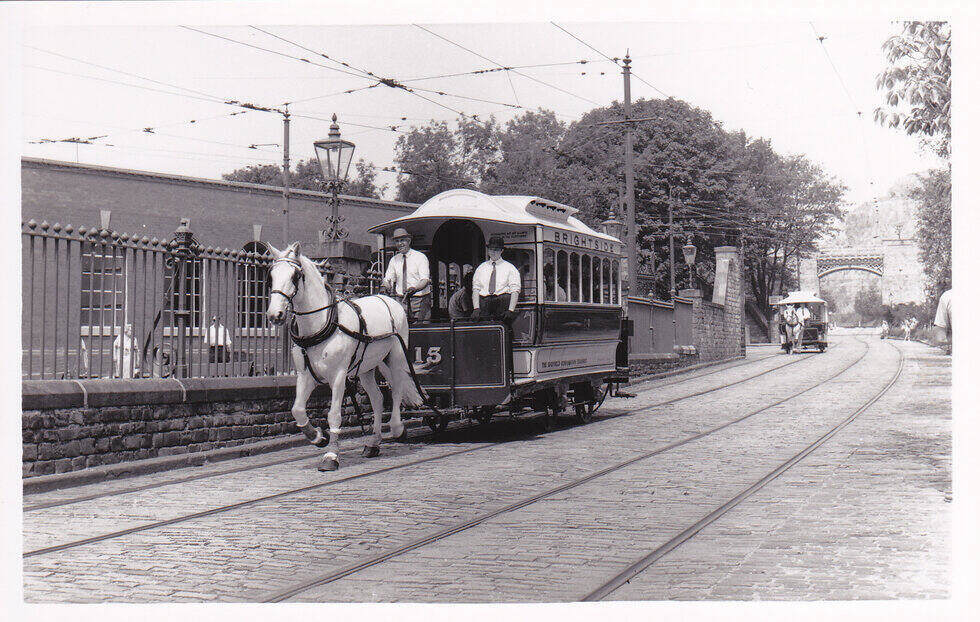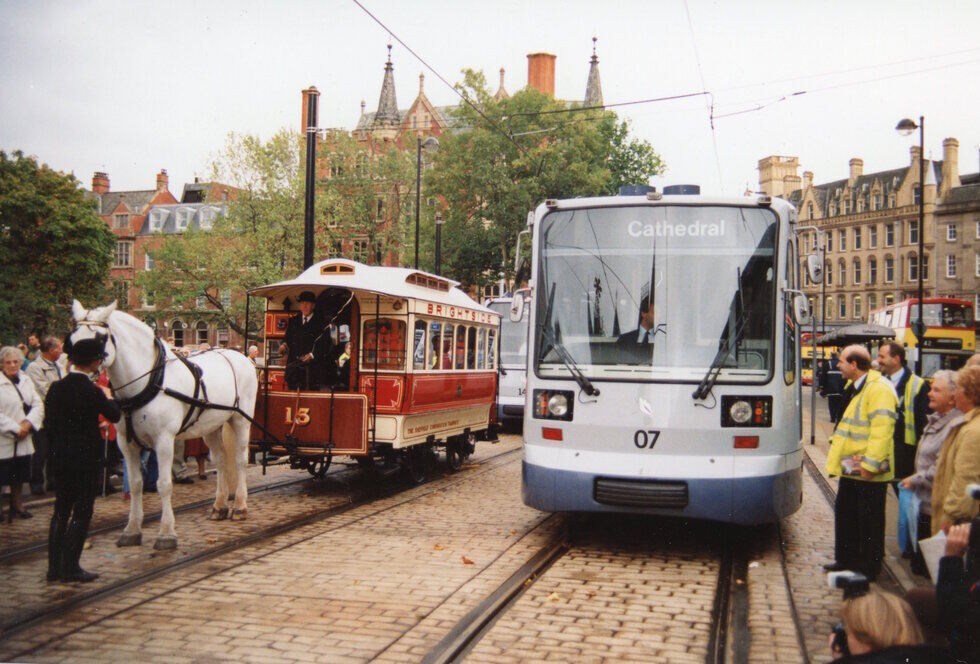Sheffield Corporation horse tram No. 15 – the second oldest tramcar in the National Tramway Museum’s collection – celebrates its 150th anniversary this autumn! Like Oporto 9, which celebrated its sesquicentenary last year, this tramcar was also built by the Starbuck Car and Wagon Company Ltd, which was based in Birkenhead.
Number 15 was one of a small batch of 8 tramcars (numbered 13-20) supplied to Sheffield Tramways Company in 1874. They operated five different horse tram services in Sheffield along a series of tram lines constructed by Sheffield Corporation. Relations between the city council and the tramway company were not altogether harmonious, however, as the former refused to allow horse trams to operate through the centre of the town (as it then was) or even for them all to be physically connected with one another.

Image 1) Sheffield horse tram routes 1873 – 1902. Source: Charles Hall, (1977), Sheffield Transport (The Transport Publishing Company), P. 45.
This image shows Sheffield’s horse tram routes 1873-1902 with those originally operated by Sheffield Tramways Company, together with those operated by Sheffield Corporation after its acquisition of the tramway. The tramway had to be operated in three separate sections, which presented the company with various operational challenges, including a duplication of repair shops and depots. The city’s hilly terrain presented another major challenge for any horse tram operators to contend with, as did the presence of numerous iron and steel works and foundries. Many of these took advantage of the Company’s tramlines when moving extremely heavy loads to and from their premises. This made it very difficult to keep the tramlines in good repair. It also meant that most of the company’s tramcars, including the double-deckers that comprised the bulk of the fleet, had to be pulled by two or more horses.
The eight new tramcars (including No. 15) that were supplied in autumn 1874 were all single-deck cars capable of being pulled by a single horse and were all intended for use on the only two lines that were reasonably level. One of these ran from Lady’s Bridge to Attercliffe, and a second from Lady’s Bridge to Brightside. The tramcars cost £200 each and could carry only 16 passengers (compared with 52 on the company’s double deck cars). Number 15 was intended to operate on the Brightside line but, as this was not completed until May 1875, it ran for a while on the Attercliffe route, which opened on 6th October 1873.

Image 2) Sister car to Sheffield 15, No. 18. Source: Charles Hall, (1977), Sheffield Transport (The Transport Publishing Company), p. 35.
The photo above shows Sheffield Tramways Company sister car no. 18 at Broughton, probably in 1875 since the route indicator reads Sheffield – Attercliffe – Carbrook, a route that the cars only ran on for a short while at around this time. The photograph appeared on page 35 of Charles Hall’s 1977 book Sheffield Transport and was said to form part of the author’s collection.
In those days, Sheffield’s horse trams were ‘colour-coded’ according to the route on which they operated. In the case of the Brightside route, this was a bright red. Number 15 was initially stored in the yard of the Bridge Inn in Brightside together with the other four cars servicing this route. A few years later, a small two-track shed was built alongside the Inn. The horses were housed in the nearby Tinsley depot. Just over two years after its arrival, the tramcar was unfortunately involved in a fatal collision in which a man was run over and killed on Brightside Lane.
In July 1896, Sheffield Corporation exercised its right to take over the running of the horse tramway from the company and not long afterwards (around 1888), number 15 was given an overhaul. As part of this procedure, the original round-topped Starbucks window frames with which the tramcar was originally equipped were replaced by the present Tudor arch-style window frames. These were felt to be more modern-looking, being similar to those on the latest Milnes horse cars (as seen on Chesterfield 8). The car’s original livery was also replaced by the one it now bears at the same time.
As part of Sheffield Corporation’s electrification process, number 15 was withdrawn from passenger service in 1901 when the Brightside route was electrified. The tram took part in a parade, together with a new electric tramcar – no. 125 – to celebrate the event. The horse tram was then given a new lease of life following its conversion to an electric breakdown car. This involved the removal of its seats, strengthening of the roof, and the installation of a heavy-duty secondary underframe. The tramcar was also equipped with electric motors and a Brill 21E truck, and when it next appeared in service it had acquired a new Prussian blue livery and the number 166. Its main role was to tow trucks and partially completed trams between the works at Tinsley and the paint shop at Nether Edge.

Image 3) Sheffield 15 in its former guise as works car no. 375 prior to its restoration as a horse tram. This wartime image has the corporation’s name blanked out. Photo by Maurice O’Connor.
The tramcar was given a Milnes girder truck in 1914 and a new number (its third) in November 1933, at which point it became 375. Its days as a works tram ended in 1946, when it was finally withdrawn. At this point, the 50th anniversary of municipal transport beckoned. As part of the celebrations, the car was re-converted to its initial horse tram guise, though still retaining its heavy electric truck. Now bearing the (incorrect) number ‘1’ (its fourth), it briefly conveyed paying passengers again for the first time in nearly half a century for a short ride between Moorhead Junction and Leopold Street at a shilling (5p) a head.
Narrowly avoiding destruction during the tramway conversion process thanks to the efforts of Sheffield Transport Department employee Charles Hall, No. 15 was eventually taken into preservation on 21st November 1959. The process of restoring it to its original state was a gradual one, beginning with the fitting of more authentic horse tram wheels in 1961.

Image 4) Sheffield 15 arriving at Crich on 21 November 1959 (the fourth tram to do so and the first to be stored under cover at the newly acquired museum site). Photograph: National Tramway Museum collection.
A reversion to its original Sheffield Corporation Brightside livery (not the Sheffield Tramways Company livery that it had initially carried) followed during a brief return visit to Sheffield Corporation’s former Queens’s Road tram workshop. Shortly after this, the tramcar was displayed during the City’s Christmas illuminations, and even carried passengers along a length of original tramway on the Moor for a brief period on 17th November 1961. This was the first time that a tramcar belonging to the Tramway Museum Society had carried passengers. This pre-dated the start of horse tram operations at Crich in 1963, which also involved Sheffield 15. For information on that, see our previous blog: https://www.tramway.co.uk/2023/06/02/60th-anniversary-of-the-first-horse-drawn-tram-at-crich/
The introduction of electric tramcar operations at Crich in 1964 put an end to regular horse tram operations for the next couple of decades, though number 15 featured in a number of ceremonial events during this period. An annual horse tram event involving Sheffield 15 and Chesterfield 8 was inaugurated on 19th August 1984 and lasted until 1991 when Sheffield 15 was temporarily withdrawn from service with a decayed underframe.

Image 5) Sheffield 15 operating a horse tram service in conjunction with Chesterfield 8 during horse tram day at Crich, 5th June 1990. Photograph by David Frodsham.
Before that happened, however, the tramcar also featured in two special celebratory events. The first involved a week-long visit to its home city in September 1987, where it was put on display outside Sheffield Cathedral as part of a special exhibition promoting the anticipated arrival of South Yorkshire’s supertram network, which opened in stages in 1994-5.
The second event involved the ceremonial opening of the recently completed Bowes-Lyon bridge at Crich, which took place in the following year. On 8th June 1988, Sheffield 15 was loaded onto a lorry for the brief journey to the short piece of tramrail running on top of the bridge. A horse was waiting to convey the tramcar over the bridge, which was officially opened by the then Transport Minister, David Mitchell.

Image 6) Sheffield 15 crosses the Bowes Lyon bridge at Crich Tramway on 8th June 1988 as part of the ‘Topping Off’ ceremony. Photograph by David Frodsham.
By this stage, the tramcar’s underframe was in a poor state of repair. This resulted in its withdrawal from service in 1991 prior to a thorough restoration that was completed in June 1995. Following a relaunch back into service at Crich, it returned to its home city for a five-month sojourn. During this period it was displayed at a ‘Sheffield on Wheels’ event at Kelham Island Museum, which formerly housed the power station that was constructed to provide electricity for the city’s electric tramcar fleet. As the visit also coincided with the completion of the city’s Supertram network, the tramcar was also able to participate in a special event to mark the occasion on 17th October 1995. This involved a photograph next to one of the new second generation tramcars and a single trip from Church Street to the Cathedral tram stop and back.

Image 7) Sheffield 15 alongside second-generation tramcar Sheffield Supertram 07, 17th October 1995. Photograph by David Beardsell.
During its long operational life at Crich, Sheffield 15 has been pulled by a succession of horses. Following the retirement of ‘Joseph’ in 2019, the tramcar has been displayed in the main Exhibition Hall as a static exhibit.

Image 8) Sheffield 15’s long and varied career in preservation at Crich is summed up by this ‘First and Last’ image featuring Sheffield 15 and Sheffield’s Last Tram, No. 510. Photograph taken 21st May 2014 by Hazel Quarmby.
With thanks to Museum volunteer Jim Dignan for producing this article.
Image References:
1) Charles Hall, (1977), Sheffield Transport (The Transport Publishing Company), P. 45.
2) Charles Hall, (1977), Sheffield Transport (The Transport Publishing Company), P. 35.
3) Maurice O’Connor.
4) National Tramway Museum collection.
5) David Frodsham
6) David Frodsham
7) David Beardsell
8) Hazel Quarmby
